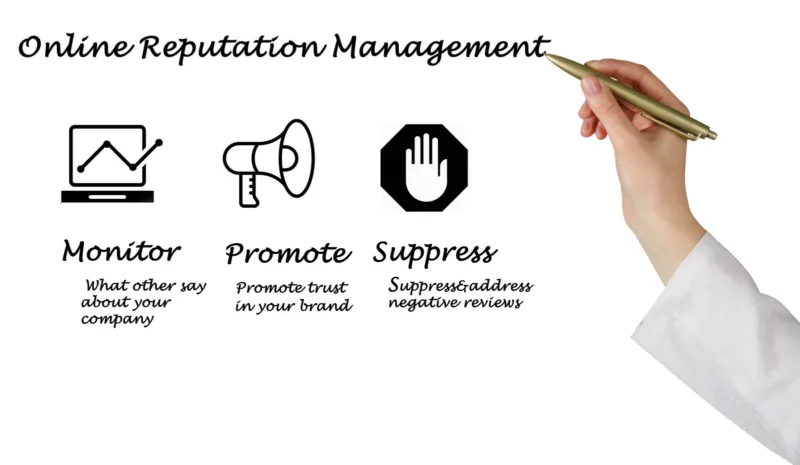Table of Contents Show
Introduction
Welcome to the intricate world of online reputation management. In an era where a simple Google search can make or break your business, understanding and managing your online reputation becomes crucial. This is especially true for home improvement businesses where trust plays a significant role in customer choices.
One major factor that has the power to sway this trust is negative Google reviews. A less-than-stellar review on your Google business page can establish doubt in potential customers and impact your business negatively. But fret not! A negative review doesn’t necessarily spell doom for your business.
Here’s some enlightening news: Negative reviews present opportunities for growth if handled correctly. Yes, you read that right! Turning challenges into opportunities is not just a cliché motivational quote but a practical strategy when it comes to dealing with negative feedback online.
This article aims to serve as your guide on how to turn negative Google reviews into business wins. We’ll delve into:
- Understanding the potential harm of these reviews
- Effective strategies for addressing them
- Showcasing real-life examples of businesses who’ve successfully transformed their online reputation
Let’s get started!

The Potential Harm of Negative Reviews for Home Improvement Businesses
In the world of home improvement, where trust and results speak volumes, online reviews can be a make-or-break factor for businesses. A solid foundation of reputation management is pivotal, as customer service and brand perception are highly influenced by the digital feedback loop. With stakes this high, understanding the detrimental impact of negative reviews is not just about damage control—it’s about survival and growth.
The Power of Online Reviews in Shaping Customer Decisions and Brand Perception
Prospective clients often turn to Google reviews as a trusted source before committing to a home improvement project. A collection of positive reviews can substantially boost a brand’s image, while negative ones can tarnish it quickly.
Negative Effects of Negative Reviews on Home Improvement Businesses
A one-star drop in ratings could deter potential customers from considering your services. Negative feedback may lead to a direct loss in sales as consumers opt for competitors with better online reputations. Poor ratings might affect search engine rankings, making it harder for your business to be found online.
Potential Harm to Business Reputation and Customer Trust
Once negative reviews permeate the digital space, they can be difficult to counteract or remove, lingering like unwanted house guests. They not only impact business owners financially but can also cause stress and anxiety, affecting overall business morale.
Statistics and Data on the Impact of Negative Reviews
- A report by BrightLocal revealed that 82% of consumers read online reviews for local businesses, with 52% stating that they would not consider using a business with less than 4 stars.
- According to ReviewTrackers, 94% say an online review has convinced them to avoid a business.
Bold action and strategic thinking are required to mitigate these effects. Engaging with dissatisfied customers demonstrates a commitment to quality customer service and may even convert critics into advocates. It’s essential not only to address negative feedback but also to harness it as a tool for improvement. As we delve into strategies for effectively responding to negative reviews, remember that each critique carries an opportunity for betterment—a chance for home improvement businesses to nail their customer service and polish their reputation until it shines.
Strategies for Effectively Responding to Negative Reviews and Resolving Issues
With the potential harm of negative reviews on your home improvement business established, let’s delve into the strategies for effectively responding to these reviews and turning them into opportunities for growth.
1. Promptly Acknowledge and Respond to Reviews
When it comes to responding to negative reviews, timing matters. Customers appreciate prompt responses, it shows that you value their feedback and are committed to resolving their concerns.
Why acknowledging negative reviews promptly matters
A quick response can go a long way in showing that you are proactive, attentive, and care about customer satisfaction. In fact, according to ReviewTrackers, 53% of customers expect businesses to respond to their online reviews within seven days. Any longer can lead to displeasure and escalate the issue.
Crafting effective responses
Crafting an effective response requires a delicate balance between empathy, professionalism, and assertiveness. Here are some tips:
- Stay calm: Negative feedback can be hard to swallow, but it’s important not to take it personally or respond with hostility.
- Thank the reviewer: Show appreciation for their feedback. It shows humility and willingness to improve.
- Address the issue directly: Express understanding of their concern and explain how you intend to resolve it.
- Keep it concise: Long-winded responses can come off as defensive. Keep your response short, sweet, and focused on resolution.
Examples of empathetic and professional responses
Wondering how this looks in practice? Here are some examples:
“Hi [Customer’s Name], thank you for bringing this issue to our attention. We’re sorry that you had a less than perfect experience with us. Your feedback is valuable in helping us improve our services. Please reach out to us at [contact info] so we can make it right.“
This response addresses the issue, shows empathy, and takes the conversation offline for resolution.
“Hello [Customer’s Name], we’re sorry to hear about your experience. We aim for a high standard of service and it seems like we missed the mark this time. We’d appreciate the opportunity to learn more about your experience and how we can make it right.“
2. Address Customer Concerns Privately to Resolve Issues
When customers leave negative reviews online, it’s important to handle their concerns in a way that shows your commitment to resolving problems. Instead of just responding publicly, you can guide the conversation to a more private space where you can have a more detailed discussion and find a solution.
Benefits of Handling Customer Concerns Privately
Addressing customer issues privately in the home improvement industry has several advantages:
- Personalized Attention: Customers feel valued when you give them individualized support.
- Better Understanding: Complex or sensitive problems can be addressed more effectively through private communication.
- Respecting Privacy: Many customers appreciate keeping their personal information and home matters confidential.
- Building Trust: Going above and beyond to solve problems shows your dedication to customer satisfaction.
Tips for Moving the Conversation Offline
Transitioning from a public review to a private conversation doesn’t have to be difficult. Here are some strategies you can use to encourage customers to reach out to you privately:
- Invite Directly: Respond publicly with an invitation to discuss the issue privately. For example, you could say, “We would love the opportunity to talk this through with you. Could you please contact us at [phone number/email] at your earliest convenience?”
- Offer Multiple Channels: Give customers options for how they can reach you, such as phone, email, or even an in-person meeting. Having choices empowers them and makes it easier for them to choose what works best for them.
- Act Promptly: Once you exchange contact information with a customer, make sure to reach out to them quickly. This shows that you take their concerns seriously and are committed to finding a solution.
- Provide Incentives: Sometimes, offering a small token of appreciation or a discount on future services can motivate customers to engage in a private conversation with you.
Real-Life Examples of Successful Resolutions
Let’s see how these strategies have worked for other home improvement businesses:
- A homeowner wrote a harsh review about a poorly done kitchen remodel. The company responded publicly, acknowledging the issue and sharing direct contact information for their customer service manager. After several phone calls and agreeing on a plan to fix the problems, the homeowner updated their review to praise the company’s dedication.
- In another case, there was a misunderstanding about project timelines that led to negative feedback online. The contractor quickly reached out via email and offered to meet in person to clarify expectations and deadlines. This not only resolved the initial issue but also resulted in the customer booking additional services.
These examples show how taking conversations offline can turn unhappy customers into satisfied ones who are willing to share positive experiences with others. By avoiding prolonged disputes on public platforms and fostering direct interactions, you can gradually build trust and improve your reputation in the home improvement industry.
3. Offer Solutions and Apologize for Any Mistakes
When responding to negative Google reviews, an essential strategy is offering solutions to customer complaints. This tactic shows customers that you’re committed to resolving their issues and improving their experience with your home improvement business.
Crafting a solution-oriented response
When formulating a response to a negative review, it’s crucial to provide a tangible solution that addresses the customer’s issue directly. For instance, if a customer complains about a faulty installation, suggest a free inspection or repair by one of your top technicians.
“Hi [Customer’s Name], we’re sorry to hear about your disappointing experience. We’d like to send our best technician over for a free inspection and repair of the installation at a time that suits you.”
This approach demonstrates your commitment to high-quality service and customer satisfaction.
Apologizing for mistakes
Let’s face it: nobody’s perfect. Even the best home improvement businesses can drop the ball sometimes. When this happens, it’s crucial to admit the mistake and apologize sincerely.
An apology shows humility and understanding, which can work wonders in rebuilding trust with disgruntled customers. Remember, it’s not just about saying “sorry,” but also conveying empathy for the customer’s negative experience.
“Dear [Customer’s Name], we’re truly sorry that our service didn’t match your expectations this time. We understand how frustrating this must be for you…”
Taking necessary action
Once you’ve issued an apology and offered a solution, it’s time for action. This step may involve internal changes like staff training or system improvements or external actions like refunding an unhappy customer or providing additional services free of charge.
“We’ve addressed this internally to ensure it doesn’t happen again. In addition, we’d like to offer you [specific remedy] as our way of making it right.”
This approach demonstrates that you’re not just all talk and no action.
Addressing negative reviews effectively requires a delicate balance of empathy, sincerity, and action. By offering solutions, apologizing for mistakes, and taking necessary steps to rectify the situation, you can turn a bitter customer experience into a potential business win.
Case Studies of Successful Resolution of Negative Reviews and Their Impact on Business Reputation
Let’s delve into some real-life examples where home improvement businesses turned the tide by successfully resolving negative reviews, thereby bolstering their business reputation.
Case Study 1: Fix-It-Fast Home Repairs
Fix-It-Fast Home Repairs is a small-scale, family-run enterprise known for its swift and reliable repair services. They had been riding high on positive customer feedback until one day they were hit with a scathing Google review that accused them of tardiness and poor workmanship.
The customer complaint was detailed and highlighted a particular incident when the team arrived late to fix a leaking pipe, which resulted in extensive water damage to the customer’s hardwood floors. Not only that, but they also cited poor communication as a significant issue.
The Fix-It-Fast team didn’t let this setback knock them down. They saw it as an opportunity to improve and rectify their mistakes. Here’s how they handled it:
- Acknowledgement: The team responded promptly to the review showcasing their commitment towards customer satisfaction.
- Apology: They apologized for the inconvenience caused to the customer due to their tardiness.
- Action: The manager personally reached out to the disgruntled customer offline, offering not only to fix any damages at no cost but also to offer a complete refund for the initial service.
This proactive approach turned things around completely. The once dissatisfied customer updated their review, expressing appreciation for the company’s quick response and willingness to make things right. This incident served as a turning point for Fix-It-Fast. They implemented stricter punctuality guidelines and improved their communication with customers, significantly enhancing their business reputation.
Now, they are often lauded online for their exceptional customer service, which has led to an increase in new business referrals from satisfied customers who were once critical reviewers.
Summarize
To summarize, Fix-It-Fast showcased that a negative review isn’t the end of the world. Instead, it’s an opportunity to learn, improve, and demonstrate your commitment to customer satisfaction. By effectively resolving the issue and satisfying the customer, they were able to transform a potential business harm into a significant business win. The business now enjoys a robust online reputation, with customers regularly praising their improvement and dedication to providing excellent service.
That’s just one example of how a home improvement business can successfully navigate through the choppy waters of negative reviews. In the upcoming sections, we will explore more case studies that highlight different strategies for handling negative reviews and improving business reputation.
Case Study 2: [Business Name]
In our exploration of case studies illustrating the power of successfully turning negative reviews into business wins, we spotlight another home improvement business that managed to transform a challenging situation into a triumph for its reputation.
Background & Challenge
A family-run home improvement company specializing in kitchen renovations was faced with a scathing Google review from a customer who felt their project was not completed to the promised standard. The review expressed dissatisfaction with the finishing details and a perceived lack of communication throughout the process.
Strategic Approach
The company took several steps to address the concerns raised in the review:
- Immediate Acknowledgement: The business responded swiftly to Google Reviews, expressing gratitude for the feedback and commitment to excellence.
- Personal Outreach: They contacted the customer directly to discuss specific grievances and to understand better what had gone wrong from the customer’s perspective.
- Problem-Solving: The company offered to revisit the project to amend any outstanding issues, providing additional services free of charge.
- Follow-Up: After rectifying the concerns, they followed up with the customer to ensure satisfaction with the final outcome.
Positive Outcomes
The resolution had multiple positive implications:
- Customer Satisfaction: The customer’s updated review reflected their appreciation for how their concerns were handled, praising the company’s dedication to customer service.
- Enhanced Reputation: Potential customers reading the reviews could see firsthand the company’s commitment to addressing and resolving issues, which reinforced trust.
- Internal Improvements: The experience led to improved internal protocols for project management and client communication.
Through these targeted actions, this home improvement business showcased its responsiveness and willingness to go above and beyond for its customers. This proactive approach not only salvaged a critical relationship but also strengthened their overall business reputation.
Case Study 3: Stellar Home Improvements
Stellar Home Improvements is a home improvement business known for its excellent kitchen and bathroom renovations. Their focus on providing high-quality work and exceptional customer service has earned them a loyal following. However, managing their reputation hasn’t always been easy.
A customer named Jane recently left a one-star review on Google expressing her frustration with the delayed completion of her bathroom renovation project. Jane’s negative reviews stood out among the positive ones, impacting Stellar’s online reputation.
How Stellar Home Improvements Handled the Situation
Stellar Home Improvements took immediate action to address Jane’s concerns and resolve the issue. Here are the steps they took:
Acknowledgment:
They responded promptly to Jane’s review, showing that they value feedback from their customers.
“Dear Jane, We sincerely apologize for the delay in completing your bathroom renovation. We understand your disappointment and appreciate your patience.”
Taking it Offline:
To discuss the specifics of the delay privately, Stellar invited Jane to contact them via email or phone.
“We’d like to discuss this further with you. Could you please contact us at our email [email protected] or give us a call at (000) 123-4567? We’re looking forward to resolving this issue.”
Offering Solutions:
After communicating with Jane privately, Stellar explained the reason behind the delay (a problem with their suppliers) and offered a partial refund as an apology for the inconvenience caused.
“After discussing with our team and suppliers, we found there were unexpected supply chain issues causing this delay. As an apology, we’d like to offer you a partial refund.”
The Result: Turning a Negative Review into a Positive One
Jane was pleased with how Stellar Home Improvements handled her complaint and made an effort to make things right. She updated her initial one-star review to four stars and even added a comment praising their customer service.
“Stellar reached out to me regarding my previous complaint. They were professional, understanding, and offered a partial refund for the inconvenience. I appreciate their effort in resolving this issue.”
This case study serves as an example of how a home improvement business can effectively deal with negative reviews. By responding promptly, engaging in open communication, finding solutions, and offering an apology, Stellar Home Improvements was able to turn a dissatisfied customer into a satisfied one and improve its online reputation in the process.
Remember, when faced with a negative review, it’s not just about minimizing the damage but also about showcasing your commitment to customer satisfaction. Ultimately, it’s an opportunity to learn and grow while strengthening your business’s reputation.
Managing Negative Google Reviews: Turning Challenges into Opportunities
1. Claim and Optimize Your Google Business Listing
As the old adage goes, “The best defense is a good offense”. In the realm of managing online reputation, the first step isn’t waiting for bad reviews to roll in but setting up your online presence to showcase the best of your home improvement business.
Importance of Claiming and Optimizing Google Business Listing
Your Google Business listing functions as the online storefront for your business. The information displayed here is often the first introduction potential customers have to your services. Ensuring this profile accurately and positively reflects your business is crucial.
- Visibility: A claimed and optimized listing increases your business’s visibility on Google search results and Google Maps.
- Credibility: A complete profile builds credibility by displaying pertinent information like operating hours, location, contact details, and photos of completed projects.
- Engagement: The space allows customers to interact with your business by leaving reviews and asking questions. Engaging with these interactions can help foster a positive relationship with customers.
Tips for Optimizing Your Google Business Listing
Crafting an engaging and optimized listing involves more than just filling out information fields:
- Photos Matter: Upload high-resolution images of completed projects, your team members at work, or even before-and-after shots that demonstrate the quality of your services.
- Highlight Services: Use the product listing feature to highlight specific services or special offers you provide.
- Update Regularly: Ensure information like operation hours, contact details, and service offerings are always current.
Utilizing Google Business Support for Assistance
Google offers assistance in properly setting up and optimizing your listings through their Google Business Support. This resource provides tutorials on how to claim a listing, update information, respond to reviews, and more.
Responding to Negative Google Reviews
When a negative review appears on your Google Business listing, it can feel like a setback. But don’t worry! You have the power to turn things around. Handling negative Google reviews is more than just damage control—it’s an opportunity to show off your customer service skills and enhance your online reputation.
Best Practices for Dealing with Negative Google Reviews
Follow these tips to effectively respond to negative reviews:
1. Act Quickly but Thoughtfully
Responding promptly shows that you take feedback seriously. Aim to reply within 24 hours, but also take the time to compose a well-thought-out message.
2. Keep It Professional
No matter the tone of the review, always maintain a polite and professional demeanor in your response. This reflects positively on your business and can help defuse tense situations.
3. Be Personal and Empathetic
Address the reviewer by their name and acknowledge their experience. Adding a touch of empathy goes a long way in demonstrating that you care about your customers’ satisfaction.
4. Show Willingness to Resolve Issues
Let the reviewer know that you are eager to resolve any problems they encounter. Taking a proactive approach helps build trust with both the reviewer and potential customers reading the conversation.
Tailoring Your Responses to Address Specific Concerns
Avoid using generic replies by customizing your message to address the specific issues raised in each review. This shows that you have taken the time to understand their situation and are genuinely interested in finding a resolution. Here are some examples:
- If a customer complains about a late delivery: “Hi [Name], we are genuinely sorry for the delay you experienced. We understand how important prompt service is and would love the chance to make this right.”
- For quality issues: “Hello [Name], it’s disappointing to hear that our work did not meet your expectations. Quality craftsmanship is our top priority, and we’d appreciate an opportunity to discuss how we can correct this issue for you.”
Examples of Effective Responses
To help you visualize the application of these best practices, let’s go through a couple of scenarios:
Scenario 1: A customer leaves a 2-star review, unhappy with the cleanup after a kitchen remodel.
Your Response:
Hi [Customer Name],
We apologize for any inconvenience caused by the post-project cleanup. Our goal is always to leave your space spotless, so it seems we missed our mark this time. Could you please contact us directly at [contact information] so we can address this matter immediately? Thank you for bringing this to our attention – we’re committed to ensuring you’re satisfied with all aspects of our service.
Best, [Your Name]
Scenario 2: A negative review cites higher-than-expected pricing.
Your Response:
Hello [Customer Name],
Thank you for sharing your concerns. We strive for transparency in our pricing and regret any confusion or surprises regarding the final cost. We’d like to explain the factors contributing to your project’s price and discuss potential solutions. Please reach out at [contact information], and let’s talk through it together.
Warm regards, [Your Name]
Remember, each reply should convey genuine concern and a willingness to address any issues raised. This shows that you value customer feedback and satisfaction above all else.
By personalizing your responses and directly addressing specific complaints, home improvement businesses can not only manage negative online reviews but also create stories of exceptional customer service that resonate with future clients.
3. Encouraging Positive Reviews and Thanking Reviewers
When it comes to managing bad online reviews, it’s important to not only address the negatives but also highlight the positives. Building a strong online reputation can greatly benefit from a steady stream of positive testimonials from happy customers. Here are some tactics to encourage those five-star reviews and create a cycle of positive feedback.
Ask for Feedback
- Don’t be afraid to ask customers for their honest opinion. You can request reviews through email follow-ups, post-service text messages, or during invoicing, making it simple for them to leave a review.
- Set up a system where your team reminds satisfied customers to share their experiences on Google right after a job well done.
Incentivize Reviews
- While you can’t offer incentives for positive reviews (as this violates Google’s policies), you can still encourage reviews in general. Think about entering reviewers into a monthly contest or providing discounts on future services.
Make It Personal
- Tailor your request by mentioning specific details about the service provided. A personalized ask can resonate more with customers, increasing the likelihood that they’ll take the time to respond.
Once those positive reviews start rolling in, it’s essential to acknowledge them. Responding to customer reviews is equally significant when they’re praising your business as when they’re expressing concerns.
Show Appreciation
- A simple thank you can make a big difference. Publicly acknowledge each positive review with gratitude and customize your message to demonstrate genuine appreciation for their support and feedback.
Share the Love
- Highlight exceptional positive reviews on your website or social media platforms (with permission, of course). This not only expresses gratitude but also exposes potential customers to real-life success stories.
Foster Loyalty
Handling negative Google reviews while creating an environment that celebrates positive feedback has a positive impact on brand loyalty. When customers feel listened to and valued, they are more likely to remain loyal—and even become advocates for your brand.
Responding promptly is crucial, whether it’s addressing concerns or celebrating praise. By personalizing responses and showing that you value all customer feedback, you establish an ongoing conversation that can turn one-time clients into lifelong supporters.
Remember that every interaction with a reviewer is an opportunity—a chance to showcase your exceptional customer service publicly, resolve any underlying issues, and reinforce the human connection between your business and its customers.
With these strategies in place, you’re on the right track to leveraging Google Business Support as one of your most valuable allies in building a strong online presence—one positive review at a time.
Conclusion
So, at the heart of it all, we’ve explored the realm of negative Google reviews for home improvement businesses. We’ve dissected their potential harm and strategies for effective resolution. Remember, every storm cloud has a silver lining. In this case, that silver lining is your business growth.
Negative feedback isn’t the enemy. It’s an opportunity disguised as criticism. Embracing this perspective allows you to transform challenges into growth catalysts for your business.
A comprehensive reputation management strategy is crucial. This not only helps in online reputation repair but also fortifies your brand against future instances. This is especially true for home services businesses, where trust is a key factor in customer decision-making.
Guidelines to Follow
To build a resilient online reputation, here are some guidelines you can follow:
- Respond promptly and professionally to all reviews: Show that you value feedback and are committed to addressing concerns.
- Move the conversation offline to address concerns privately: Provide contact information so that unhappy customers can reach out to you directly.
- Offer solutions and apologize for mistakes: Take responsibility for any errors and demonstrate a willingness to make things right.
- Encourage satisfied customers to leave positive reviews: Actively seek out positive feedback from happy customers to balance out negative reviews.
- Always thank your reviewers: Show appreciation for both positive and negative feedback.
Implementing these tactics helps in building a resilient online reputation that can weather any storm (or negative review). And remember, when handled correctly, even the most scathing review can become a testimony to your commitment to customer satisfaction.
In essence, it’s about turning lemons into lemonade – making the most out of every situation and using it to strengthen your business. So let’s raise a glass to growth and resilience that emerges from embracing and addressing negative reviews!
FAQs(Frequently Asked Questions)
Acknowledging and responding to negative reviews promptly is crucial as it shows that you are proactive in addressing customer concerns and are committed to providing excellent service. A quick response can also help mitigate any potential damage caused by the negative review.
Addressing customer issues privately in the home improvement business can lead to more personalized and effective resolutions. It also shows other potential customers that you take their feedback seriously and are willing to go the extra mile to make things right.
How should businesses craft solution-oriented responses to negative reviews?
Crafting a solution-oriented response involves empathizing with the customer’s experience, offering a genuine apology for any mistakes, and presenting a clear plan of action to resolve the issue. It’s important to focus on finding a resolution rather than justifying or defending the business.
What are some tips for encouraging positive reviews and thanking reviewers?
Businesses can encourage positive reviews by asking for feedback, incentivizing reviews within ethical boundaries, personalizing their requests, showing appreciation for customers who leave reviews, and sharing exceptional positive reviews on their websites or social media platforms. These practices can help foster loyalty and improve overall brand perception.
Why is it important to claim and optimize your Google Business listing?
Claiming and optimizing your Google Business listing is essential as it serves as the online storefront for your business. It allows you to provide accurate information about your services, engage with customers through reviews, and improve your visibility in local search results. This proactive approach helps in managing your online reputation effectively.
What are some best practices for dealing with negative Google reviews?
Best practices for dealing with negative Google reviews include responding promptly, addressing specific concerns raised by the reviewer, avoiding generic replies, and maintaining a professional tone. Tailoring responses to each review and showcasing empathy can demonstrate a commitment to resolving issues and improving customer satisfaction.
Citation
- ReviewTrackers. “How to Respond to Negative Reviews | ReviewTrackers.” Last modified March 1, 2023. Accessed January 5, 2024. https://www.reviewtrackers.com/guides/examples-responding-reviews/.
- Surefire Local. 2016. ’10 Ways to Respond to Reviews in the Home Improvement Industry.’ YouTube video, 1:43:02. https://www.youtube.com/watch?v=rEINy6kWiL4. Accessed January 5, 2024.
- Ads Grow Business. 2022. ‘How To Convert Negative Reviews Into Positive Ones & Why They Are Not As Bad As You Think | PART 2.’ YouTube video, 2022-09-05T12:17:45Z. https://www.youtube.com/watch?v=KujdSBYvBMo (accessed January 10, 2024).
- Checkfront. “How to Respond to a Bad Google Review (Example Included).” Last modified July 3, 2023. Accessed January 15, 2024. https://www.checkfront.com/blog/how-to-respond-to-negative-travel-reviews/
- Main Street ROI. “How to Respond to Negative Reviews on Google: 3 Steps to Take.” Main Street ROI. Accessed January 10, 2024. https://www.mainstreetroi.com/how-to-handle-bad-google-reviews-like-a-pro/.
- Company 119. “How to Handle Negative Google Reviews | Company 119.” Last modified December 22, 2023. Accessed January 11, 2024. https://www.company119.com/insights/handling-negative-google-reviews/.
- Barloso, Kim. 2020. “How to Turn Negative Reviews into Marketing Wins.” Rize Reviews. Last modified September 7, 2020. Accessed January 12, 2024. https://rizereviews.com/how-to-turn-negative-reviews-into-marketing-wins/.
- Campbell, Anita. ‘Essential Steps to Handle Negative Reviews.’ U.S. Small Business Administration. October 4, 2018. Accessed January 10, 2024. www.sba.gov/blog/essential-steps-handle-negative-reviews.
- Google for Small Business. “How to Respond to Good & Bad Reviews – Google for Small Business.” Accessed January 13, 2024. https://smallbusiness.withgoogle.com/free-google-training/how-to-respond-to-google-reviews/










